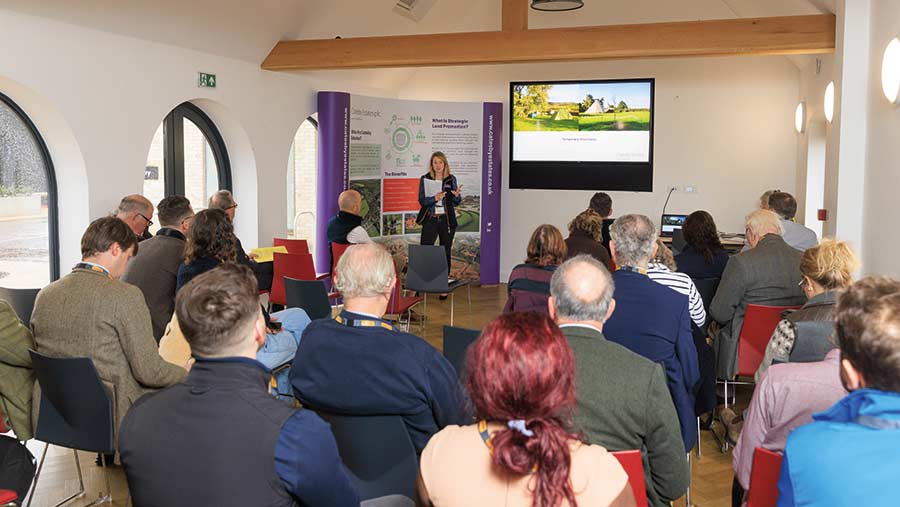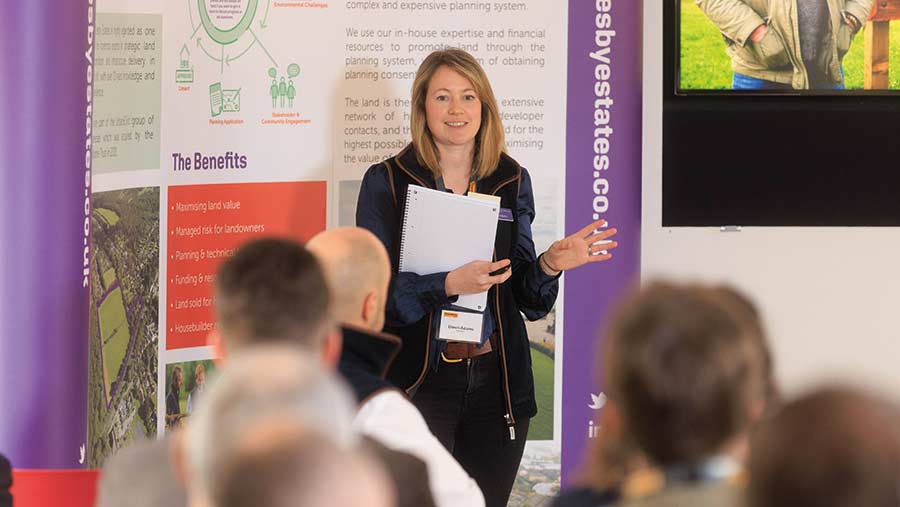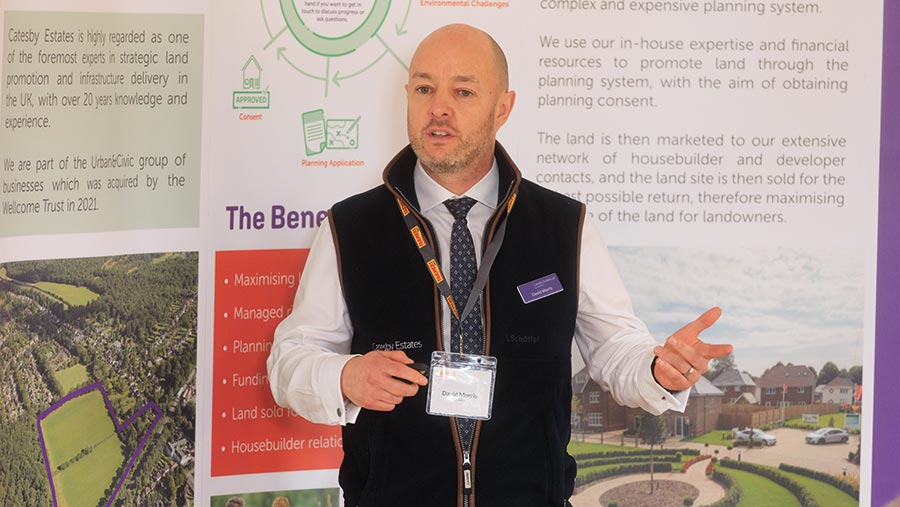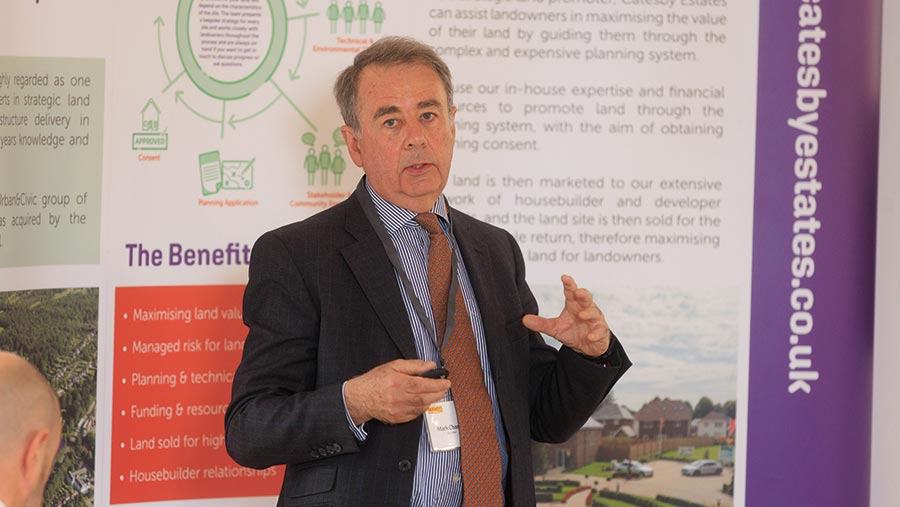Changing land use – tax, legal and planning considerations
 © Tim Scrivener
© Tim Scrivener The latest Defra farm business survey shows that 68% of UK farms have some form of diversified activity.
From smaller-scale alternative business ventures such as camping and hosting weddings, to developing major solar and housing projects, there are many opportunities to use land in different ways.
See also: 15 fresh ideas for making money or cutting costs on farm
A recent Farmers Weekly event at the Houlton housing development near Rugby heard a wealth of advice on what to consider and pitfalls to avoid.
Planning
Government policies on planning are generally supportive of farm diversification but at the local planning level this is not always upheld.
Dawn Adams, associate planning director at Catesby Estates, said it could take months to assemble an application but the outcome was decided in front of a planning committee balancing competing issues.
“Politics can therefore never be removed from the planning system,” she said.
Ms Adams advised applicants to make best use of their parish council or ward councillor from the outset.
“They can be enormously helpful and equally obstructive, depending on their outlook on applications, so early conversations to explain the benefits of the application are helpful.”

Dawn Adams, associate planning director at Catesby Estates © Tim Scrivener
Consider making a pre-application enquiry with the local planning authority (LPA).
This is optional but can help understand how development policies specific to the LPA apply, identify potential problems and rectify those before a full planning application is submitted.
“It can be expensive but worth the investment in setting the tone. It shows you have gone out of your way to understand the system and what the council requires,” said Ms Adams.
Partnering with a third party, such as a land promoter who understands the authority and the people involved, can also result in better outcomes.
Prepare for delays
Planning is not quick. “It will take longer than you think,” Ms Adams warned. Essential procedures such as ecology surveys can inject delay.
Certain species surveys are required to be carried out at specific times – generally from April to October – and these can substantially delay applications or building works if they cannot be carried out until the following season.
“This is why it is essential to conduct the survey as early as possible in the project,” said Ms Adams.
From November 2023, all planning permissions granted in England will need to demonstrate a 10% uplift in biodiversity – a biodiversity net gain (BNG) which can be achieved by creating new habitats or enhancing existing ones.
“There is no requirement to have the offsetting in the same local authority area as the development, but the further away, the higher the cost,” said Ms Adams.
Tax
Diversification often makes good commercial sense, but without careful tax planning the favourable and generous reliefs available to farm businesses can be lost.
Keith Johnston, agricultural tax specialist at accountant Armstong Watson, said that when considering how these reliefs have been applied, HMRC looked at a farming business in the round, taking into account how the land was used and occupied.
Any activity that diversified from agricultural use could risk the whole business not qualifying for agricultural property relief (APR), he warned.
“It doesn’t matter how many enterprises a farm business in the traditional sense has lumped together – arable, livestock, dairy – they are taxed as one, but as soon as you diversify, in the eyes of the tax man it is not classed as agriculture.”

Keith Johnston, agricultural tax specialist at Armstong Watson © Tim Scrivener
While APR may be lost, business property relief (BPR) can in some cases be applied to help reduce inheritance tax (IHT) but this is less generous.
To qualify for BPR, the land must be used for trading, to generate an income, rather than as an investment.
When it comes to diversification, there could be a fine balance between qualifying for APR, BPR or losing all IHT reliefs, said Mr Johnston.
“If, for example, the diversification is for battery storage and the business is paid a rent of £300,000 annually, the market value of the lease on those acres is going to be worth more than it would be for agricultural land.
“It would therefore be considered an investment and wouldn’t qualify for APR, not even BPR because, as a result, the business is at risk of being deemed to be a predominantly investment activity and no BR is due, even on the livestock and machinery.”
Regular reviews of tax position
Mr Johnston recommends regularly reviewing the business accounts to ensure that it remains predominantly a trading enterprise without too many investment activities.
“It may involve getting a land agent to advise on the valuation. You have to be constantly reviewing as circumstances and valuations change.”
The order in which the planned diversification happens is an important consideration.
Get the timing wrong and it can mean paying 20% capital gains tax (CGT) on a sale and, after a death, the estate being liable for 40% IHT.
“Reliefs are often reliant on getting the right advice in place early in the development process,” Mr Johnston advised.
The recent rise in the corporation tax rate to 25%, with a further 8.75% income tax payable on dividends, makes the tax saving benefits of a company structure less significant.
However, Mr Johnston points out that for someone diversifying into an activity with greater risk associated with it than farming, a company structure has the benefit of limited liability and is still appropriate in many cases.
Development partners and legal considerations
Developing land for large scale diversification is complex, so some landowners opt to share the risk, and the rewards, with a third party.
Richard Foxon, managing director of land and property agency Newton LDP, said there were several avenues available to a landowner wishing to develop strategic land, including promotion, option and hybrid agreements.
“Is it money upfront that’s important, or would you rather maximise receipts at the end of the process? Not everyone wants the highest price.
“Legacy and quality may be a consideration rather than necessarily seeking the highest possible pay cheque,” he said.
Focusing on the objective will help inform which type of agreement will work best.
Strategic development could be an “emotional rollercoaster” at times, Mr Foxon added, and more often than not would take much longer than expected.
“It’s important that landowners focus on their underlying business rather than lose focus due to an expectation of significant capital receipts,” he said.
“Any agreement must have clear objectives, as those will form the DNA of the agreement which all obligations will link back in to.”
Taking advice from an experienced team of professionals at the very outset of any venture was imperative, said Mr Foxon.
“Far too often we are dragged in to try and rescue a problem situation when it is sometimes too late.”
Check LPA criteria
David Morris, planning and operations director at Catesby Estates, advised that for housing development, landowners should run through a checklist of important criteria that LPAs scrutinise, in order to gauge the chances of securing planning consent.

David Morris, planning and operations director at Catesby Estates © Tim Scrivener
“Does it look like a logical extension of the settlement, is the land protected from flooding, is there a local housing need?” he said.
“The connectivity of sites is becoming much more important too, with pressure to reduce reliance on cars, so could residents walk to the shops from the proposed site? Is there a local bus service?”
Solicitor Mark Charter, of Thrings, said a promotion agreement aligned the interest of the landowner and the promoter in achieving maximum price in the open market.
In such an arrangement the promoter takes on the financial risk of getting planning permission on the land and, once that is secured, finding a buyer.
The cost of obtaining planning permission is reimbursed to the promoter, who also takes a cut of the land sale price.
Both promoter and landowner have an interest in securing a sale at the highest price.

Mark Charter, solicitor, Thrings © Tim Scrivener
Under an alternative route, an option agreement, Mr Charter explained that the landowner and developer were less aligned, as the developer would want to buy the land at the lowest possible price.
An option agreement gives a developer the right to buy land within a specified timescale and, in return, the developer will take on the obligation of applying for planning permission at their own cost.
If they are successful in obtaining planning consent, the developer can then decide whether to exercise the option and purchase the land.
The price paid can either be based on open market value with a discount (and with the precise sum agreed or negotiated once planning permission is granted) or, in the case of smaller developments, at a fixed price.
Where the price is based on market value with a discount, Mr Charter strongly advised that a minimum should always be stated under which the landowner is not obliged to sell.
A third alternative – a hybrid agreement – is often used for big strategic housing developments because some phases will be bought by the developer entering into the hybrid agreement, under option arrangements, and other tranches sold to other developers on the open market.
Mr Charter said this helped give landowners a good understanding of current land values and reassured them that the market, under a hybrid agreement arrangement, was periodically tested.
Beware exclusivity
He warned landowners to be wary of signing exclusivity agreements.
“Don’t sign one that is longer than three months or you may find yourself unnecessarily locked out of the market,” he advised.
Mr Charter said landowners may need to think about capturing future value – this could be through overage agreements which required a buyer to pay the seller a percentage of any increased value of the land in future.
They also needed to be careful about capturing enhanced value under leases for renewable projects, he added.
Insisting on a turnover rent would allow the landowner to share the benefit of any increase in productivity resulting from the installation of new technology on an existing site.
